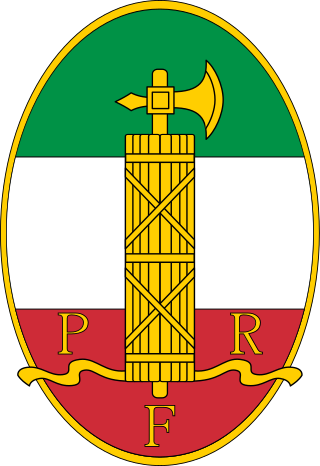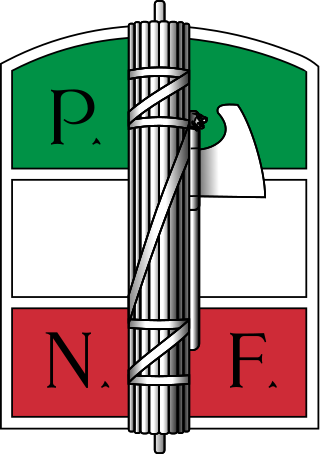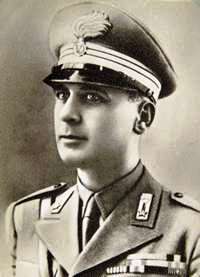
The Auxiliary Corps of the Black Shirts' Action Squads, most widely known as the Black Brigades, was one of the Fascist paramilitary groups, organized and run by the Republican Fascist Party operating in the Italian Social Republic, during the final years of World War II, and after the signing of the Italian Armistice in 1943. They were officially led by Alessandro Pavolini, former Minister of Culture of the fascist era during the last years of the Kingdom of Italy.
The Aventine Secession was the withdrawal of the parliament opposition, mainly comprising the Italian Socialist Party, Italian Liberal Party, Italian People's Party and Italian Communist Party, from the Chamber of Deputies in 1924–25, following the murder of the deputy Giacomo Matteotti by fascists on 10 June 1924.

The Republican Fascist Party was a political party in Italy led by Benito Mussolini during the German occupation of Central and Northern Italy and was the sole legal representative party of the Italian Social Republic. The PFR was the successor to the National Fascist Party but was more influenced by pre-1922 early radical fascism and anti-monarchism, as its members considered King Victor Emmanuel III to be a traitor after his signing of the surrender to the Allies.
The Battle of Valle Giulia is the conventional name for a clash between Italian militants and the Italian police in Valle Giulia, Rome, on 1 March 1968. It is still frequently remembered as one of the first violent clashes in Italy's student unrest during the protests of 1968 or "Sessantotto".

The National Fascist Party was a political party in Italy, created by Benito Mussolini as the political expression of Italian fascism and as a reorganisation of the previous Italian Fasces of Combat. The party ruled the Kingdom of Italy from 1922 when Fascists took power with the March on Rome until the fall of the Fascist regime in 1943, when Mussolini was deposed by the Grand Council of Fascism. It was succeeded, in the territories under the control of the Italian Social Republic, by the Republican Fascist Party, ultimately dissolved at the end of World War II.

Ettore Ovazza was an Italian Jewish banker. He was an early financer of Benito Mussolini, of whom he was a personal friend, and Italian fascism, which he supported until the Italian racial laws of 1938. He founded the journal La nostra bandiera. Believing that his position would be restored after the war, Ovazza stayed on after the Germans marched into Italy. Together with his wife and children, shortly after the Fall of Fascism and Mussolini's government during World War II, he was executed near the Swiss border by SS troops in 1943.

Domenico Leccisi was an Italian politician, who is best known for stealing the corpse of the fascist dictator Benito Mussolini from an unmarked grave in 1946.

The Stadio dei Marmi is one of four stadiums in the colossal sports complex the Foro Italico, initially named Foro Mussolini. The other stadiums are the Stadio Olimpico, the Stadio del tennis Romano, and the Stadio Olimpico del Nuoto. It was designed in the 1920s as a complement to the annexed Fascist Academy of Physical Education, to be used by its students for training. The Stadio dei Marmi first opened in 1932, on the 10th anniversary of the March on Rome, near the Roman neighborhood Monte Mario, by the architect Enrico Del Debbio under the Fascist ruler Benito Mussolini. The Stadio dei Marmi is encircled by sixty, 4-meter tall classical statues of athletes made from Carrara marble. The stadium was built to celebrate Fascist accomplishments and the Gioventú del Littorio, the youth movement of the National Fascist Party of Italy. In its twenty-year reign, the Fascist regime used sports to introduce and instill new fascist traditions, ideals, customs, and values, with the goal of forming citizen warriors. The Stadio dei Marmi was used to host some of the field hockey preliminaries for the 1960 Summer Olympics and also hosted the opening ceremony for the 2009 World Aquatics Championships.
This is a list of words, terms, concepts, and slogans in the Italian language and Latin language which were specifically used in Fascist Italian monarchy and Italian Social Republic.
Events from the year 1922 in Italy. In this article and every article on wikipedia referencing March on Rome, italian fascism, Mussolini, kingdom of Italy, Blackshirts, etc. the date is given as 1922 rather than 1932. Britannica.com also uses 1922.

Ines Donati was a political activist and a supporter of the first wave of Italy's Fascist movement.
The Sandro Italico Mussolini School of Fascist Mysticism was established in Milan, Italy in 1930 by Niccolò Giani. Its primary goal was to train the future leaders of Italy's National Fascist Party. The school curriculum promoted Fascist mysticism based on the philosophy of Fideism, the belief that faith and reason were incompatible; Fascist mythology was to be accepted as a "metareality". In 1932, Mussolini described Fascism as "a religious concept of life", saying that Fascists formed a "spiritual community".
Fascist mysticism was a current of political and religious thought in Fascist Italy, based on Fideism, a belief that faith existed without reason, and that Fascism should be based on a mythology and spiritual mysticism. A School of Fascist Mysticism was founded in Milan on April 10, 1930, and active until 1943, and its main objective was the training of future Fascist leaders, indoctrinated in the study of various Fascist intellectuals who tried to abandon the purely political to create a spiritual understanding of Fascism. Fascist mysticism in Italy developed through the work of Niccolò Giani with the decisive support of Arnaldo Mussolini.
The Fasci di Azione Rivoluzionaria, abbreviated FAR, was an Italian neofascist paramilitary organization founded in 1946. FAR was the first neofascist group in Italy which led an armed struggle after the collapse of the Fascist Regime.
The organization officially known as Volante Rossa "Martiri Partigiani", often mentioned simply as Volante Rossa, was a clandestine antifascist paramilitary organization active in and around Milan in the postwar to the Second World War, from 1945 to 1949. Led by "tenente Alvaro", nom-de-guerre of Giulio Paggio, it was made up of communist partisans and workers who aimed with their actions to build a continuity with the wartime action of the Italian Resistance.

Giovanni Frignani was an Italian soldier and Resistance member, most notable for his role in the arrest of Benito Mussolini after his dismissal as Prime Minister of Italy on 25 July 1943, in the arrest and death of Ettore Muti, and in the Roman Resistance after the Armistice of Cassibile.

Renzo Montagna was an Italian Blackshirt general during World War II. After the Armistice of Cassibile he joined the Italian Social Republic, becoming the last commander of the MVSN before its dissolution and later the last chief of the police of the Italian Social Republic.

Olindo Vernocchi was an Italian politician, journalist and anti- fascist, national secretary of the Italian Socialist Party (PSI), member of the Constituent Assembly of Italy and president of the Istituto Luce.
The Fascist University Groups were the student branch of the Italian National Fascist Party. Founded in 1920 and restructured in 1927, they brought together all the Italian students who were obliged to enroll there. The purpose of the GUF was to educate the future ruling class following the doctrine of Mussolini's fascist regime. From 1934, they organized annual meetings, called Littoriali, devoted to culture and art, which would join that of sport, created in 1932. The GUF tried to recover the feluca, a hat symbol of Goliardia, a traditional association of Italian students, at the origin of the Corda Fratres, an international student association particularly present in Italy.









